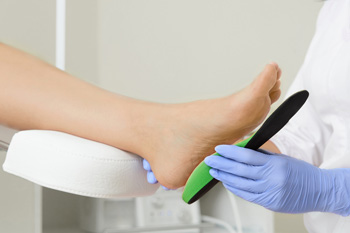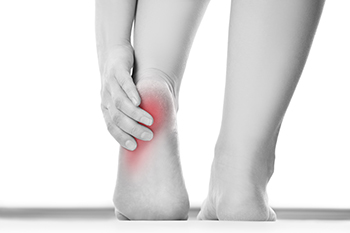Items filtered by date: February 2023
Running With Flat Feet

Having a low or absent arch in the feet is known as flat feet. Most adults will have the arches develop in the teenage years, as most babies are born with flat feet. If the arch doesn’t form, it may be a result of genetic factors, diabetes, or muscular disorders. Additionally, pregnancy and obesity may contribute to having flat feet. Many people enjoy running, and pain and discomfort may be reduced when implementing specific strategies. These can consist of maintaining a healthy weight and keeping the body strong. Training properly is a key factor when running with flat feet, and will often include proper stretching, warming up, and cooling down. Custom-made orthotics may help some patients to run easier, and if you would like more information about this topic, it is suggested that you consult with a chiropodist.
Flat feet are a common foot condition. If you are experiencing pain or discomfort due to flat feet, please consult with Chiropodist Stephanie Poupore from North Bay Foot & Ankle. Our clinician will assess your condition and provide you with quality foot and ankle treatment.
What Are Flat Feet?
Flat feet are feet that do not have a well-defined arch in the middle of the sole of the foot. Flat feet may be flexible or rigid. Flexible flat feet have an arch when there is no pressure put on the foot, such as when one is sitting, but the arch disappears upon standing. Rigid flat feet lack an arch regardless of whether one is standing or not.
Causes
Flat feet can be present from birth or acquired over time due to a weakening of the ligaments in the arch. Sometimes flat feet are caused by illnesses, injuries, or pregnancy.
Symptoms
Flat feet often cause no noticeable symptoms. However, some people may experience pain and discomfort due to their flat feet.
Symptoms associated with flat feet include:
-
Pain in the arch, heel, ankle, or along the outside of the foot
-
Overpronation of the foot
-
Shin splints
-
Aching or fatigue in the feet or legs
-
Pain in the knees, hips, or lower back
Treatment
In cases where flat feet cause symptoms, there are various treatments available. Wearing orthotic inserts in your shoes to provide more arch support, performing stretches, and taking medications may improve your symptoms. If you are overweight, losing weight can help relieve pressure on the feet. In severe cases, surgery may be considered.
If you have any questions, please feel free to contact our office located in . We offer the newest diagnostic and treatment technologies for all your foot care needs.
Ways Orthotics Help With Foot Pain

A surprising number of common foot ailments can be helped by wearing inserts in your shoes. Termed orthotics, these devices can help to counteract the effect of gait issues, deformities, and other maladies that cause pain. People with chronic foot pain are prime candidates for orthotics. Many inserts are available over the counter as a one-size fits all product, but a chiropodist can prescribe custom orthotics designed specifically for your foot. For example, if you have chronic ankle sprains, a custom orthotic can redistribute your body weight accordingly and help to stabilize the joint. To help determine the best orthotics for you, several tests will be taken, including the range of motion, muscle strength, and bone placement when you stand. Your walking pattern, or gait, also will be examined. A cast or digital image of your foot will be taken from which the custom orthotic will be made. The use of orthotics is generally accompanied by other treatment methods to correct your foot issues. Please consult a chiropodist for further details.
Orthotics are devices that are typically inserted into shoes to treat a variety of foot and ankle problems. If you would like to learn more, please consult with Chiropodist Stephanie Poupore from North Bay Foot & Ankle. Our clinician can help you maintain the health of your lower limbs and your mobility.
What Are Orthotics Used For?
Orthotics are used for the treatment of a variety of foot and ankle problems. These can include biomechanical issues, gait abnormalities, foot pain, injuries, arthritis, deformities, and other medical conditions that affect the lower limbs. Orthotics can be bought in a store or custom-made and prescribed by a chiropodist.
Types of Orthotics
-
Rigid - Made from carbon fiber or other hard material and designed to ease foot pain and strain
-
Soft - Made from flexible materials like foam and designed to cushion and support the foot
-
Full shoe inserts
-
Half shoe inserts
-
Heel cups
-
Heel pads
-
Night splints
-
Braces
-
And more
If you have any questions, please feel free to contact our office located in . We offer the newest diagnostic and treatment technologies for all your foot care needs.
Are You Suffering From Nerve Damage?
What Is Tarsal Tunnel Syndrome?

Although its name might sound complicated and scientific, tarsal tunnel syndrome is a foot condition that is relatively easy to understand. Essentially, this condition of the foot develops in patients when the tibial nerve becomes damaged in some way. The damage is typically a result of some compression. Importantly, this nerve is located in the passageway known as the tarsal tunnel. As a result of this condition, a patient might feel any number of different symptoms. For example, a patient might experience some degree of burning or tingling in the feet. If you are feeling any of these symptoms, it is recommended that you reach out to a chiropodist. This medical professional is well-versed in all things concerning tarsal tunnel syndrome. Consider scheduling an appointment today.
Tarsal tunnel syndrome can cause pain and progress over time. If you are experiencing any symptoms of tarsal tunnel syndrome, please consult with Chiropodist Stephanie Poupore from North Bay Foot & Ankle. Our clinician will assess your condition and provide you with quality foot and ankle treatment.
What Is Tarsal Tunnel Syndrome?
Tarsal tunnel syndrome is a condition in which the posterior tibial nerve, which is located within a structure called the tarsal tunnel on the inside of the ankle, is squeezed. Compression of the posterior tibial nerve can be caused by injuries, such as ankle sprains, systemic diseases like diabetes or arthritis, strain on the tarsal tunnel due to flat feet, or an enlarged structure like a cyst squeezing the nerve.
Symptoms
Symptoms of tarsal tunnel syndrome can appear suddenly and are generally worsened by physical activity.
Common symptoms include:
-
Tingling, burning, or electrical shock sensation on the inside of the ankle or bottom of the foot
-
Numbness
-
Shooting pain
Diagnosis
Tarsal tunnel syndrome is diagnosed through physical examination. If initial treatment is ineffective, imaging or nerve studies may also be necessary.
Treatment
Nonsurgical treatments for tarsal tunnel syndrome include resting and icing the foot, bracing or immobilizing the foot, wearing an orthotic device, modifying your footwear, and taking medications to relieve pain. Surgery may be needed if nonsurgical treatments are ineffective.
If you have any questions, please feel free to contact our office located in . We offer the newest diagnostic and treatment technologies for all your foot care needs.
Pain in the Heel

Heel pain is more common in kids than might be expected. Symptoms of heel pain can include tenderness in the back of the foot or ankle, and limping or walking on tiptoes. Heel pain may be the result of Achilles tendinitis or Sever’s disease. Sever’s disease, or calcaneal apophysitis, is the most common cause of heel pain in children ages five to 11 who participate in sports. This condition can happen when the Achilles tendon pulls on the growing heel bone. Achilles tendinitis can occur in children when there is a sudden increase in activity. The Achilles tendon attaches the muscles in the calf to the heel bone, and assists in pushing the foot forward while walking and running. Typically, heel pain in children comes from overuse in participating in sports. If there is a known connection between heel pain with a specific sport, it is beneficial to temporarily stop that activity so the child can rest. If the pain persists, it is suggested to seek a proper diagnosis and treatment from a chiropodist that may prevent heel injuries and chronic pain from developing.
Heel pain is a common problem that can be caused by a variety of injuries, medical conditions, and other factors. If you suffer from heel pain, please consult with Chiropodist Stephanie Poupore from North Bay Foot & Ankle. Our clinician can help you maintain the health of your lower limbs and your mobility.
When it comes to heel pain, the exact location and type of pain are important to note. Some of the conditions that may cause heel pain include:
-
Plantar fasciitis - An inflammation of the ligament that runs along the bottom of the foot; it causes a stabbing pain under the heel that is at its worst when taking your first few steps after a long rest and while standing on your tiptoes or climbing stairs
-
Achilles tendonitis - An inflammation of the tendon in the back of the calf; it causes pain in the back of the heel that is at its worst after resting, as well as ankle and calf stiffness, swelling, and tenderness
-
Bone spurs - Bony lumps on the back of the heel bones that cause sharp pain upon first standing up; the pain becomes dull and achy over time
-
Heel fractures - A break or crack in the heel bone that causes pain, swelling, and difficulty walking
-
Retrocalcaneal bursitis - Swelling of the small, fluid-filled sac at the back of the heel bone; it causes pain, swelling, redness, and warmth in the back of the heel
-
Tarsal tunnel syndrome - Compression of the posterior tibial nerve which causes a pins and needles sensation in the heel, foot, and calf
Your chiropodist will be able to diagnose the underlying cause of your pain and prescribe the right treatments for you. If you have any questions, please feel free to contact our office located in . We offer the newest diagnostic and treatment technologies for all your foot care needs.

